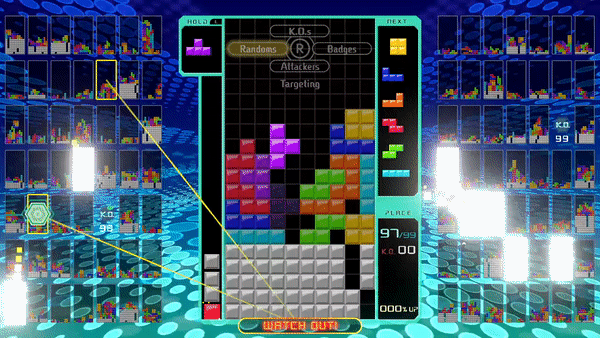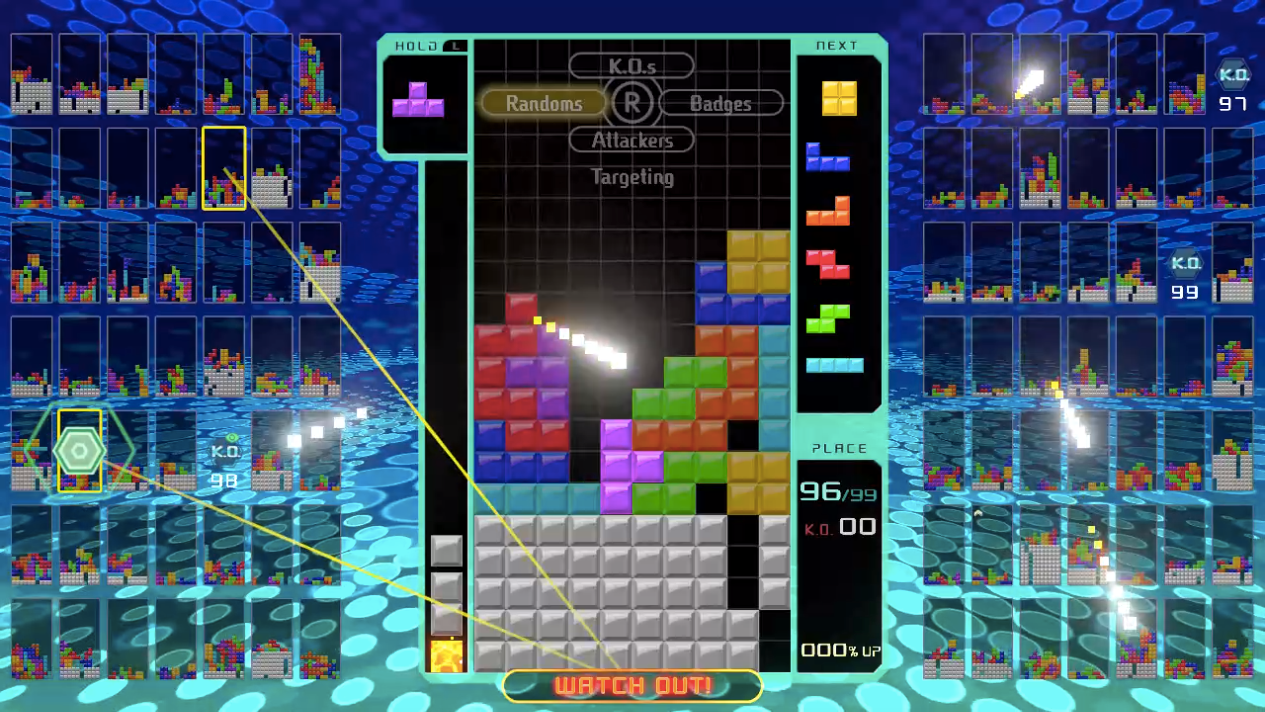How to Play: Tetris 99
The one true king of puzzle games returns with a vengeance. This time Tetris is a free-to-play battle royale game, with 99 players competing to see who has the best line-clearing skills. Winning a match is going to be a steep challenge, because—much like Highlander—there can be only one.
While Tetris 99 is very easy to pick up and play, it assumes you’ve played Tetris before. The game has few options to tweak, and almost no in-game explanations for anything, so some prior familiarity is required. With that in mind, here are some tips and tricks to help you take on these massive block battles.
Use the Hard Drop
Really old-school Tetris players tend to favor accelerating pieces downward (by pressing Down), rather than the instantaneous plummet of the Hard Drop (performed by pressing Up). This is because most people’s favorite version of Tetris—the original Game Boy and/or NES versions—did not have this move. But whether you are in the purist camp or not, you’re going to want to keep the Hard Drop turned on.
The fact of the matter is that the puzzle action in Tetris 99 is fast. You will need to clear lines as quickly as possible when things heat up and the Hard Drop is simply the best way to do it. Plus, your falling piece’s shadow at the bottom of the screen—the visual indicator of where the tetromino will land should you drop it—cannot be turned off. So the game was clearly designed with Hard Drops in mind; you might as well make use of it.
Save specific pieces for later
Much like Hard Drops, holding a piece for later is a newer Tetris innovation that we didn’t have on the Game Boy. Purists might even consider it cheating. But again, this game was clearly designed with holds in mind, and there is no option to turn them off, so let’s move right to acceptance.
Pressing the L button will capture the piece you currently have in play, saving it the box in the upper left. If you already have a tetromino held then pressing L will swap out your current piece for the held one. Please note that you once swap a held piece you have to play it immediate—you can’t press L again to re-hold the piece. (You’d only want to do this if you accidentally swapped out your holding piece anyway.)
The simplest strategy, in my opinion, is to hold onto a long piece while you build up lines for a tetris. A held long piece can also come in handy when another player starts to pile garbage on you. A different option might be to hold Z or S blocks if they appear at a time that you don’t have a fitting spot to place them.
Master the T-Spin
If you’ve made a mistake and left a weird gap in your lines, you can always try to slip a T block in there with a T-Spin.
Like most recent versions of Tetris, 99 will allow you to repeatedly rotate a piece that has landed—preventing it from locking in place—seemingly indefinitely. While this normally would only serve to slow you down, it can actually make for some interesting opportunities with the T block.
To pull off a T-Spin, look for a T-shaped gap in your lines, likely with a two-block opening at the top. If you can get the T block through, then just rotate the piece until it fits the gap. Et voilà, that’s a T-Spin! Other T-Spin possibilities also exist, so keep an eye out. You’re likely to know them when you see them.
Selecting your targets
Traditionally in versus Tetris, clearing multiple lines will push lines of Garbage Blocks onto your opponent’s screen. Clearing two lines pushes one line of garbage onto your opponent, clearing three lines pushes two lines of garbage, and getting a tetris will actually push all four of your lines as garbage. So the bigger line clears you can produce, the better.
Of course in Tetris 99, you’ve got a lot more opponents than before. So who ends up getting your garbage blocks? Well, you actually chose this mid-game. Using the Left Analog Stick, you can freely move a hexagonal cursor to select a specific opponent to target. This can be a bit hard to do whilst also focusing on your game board, but the option to pin-point one player is always there.
The panel on the left side of your game board shows you how much garbage is headed your way.
The other, simplified way to select your targets is to the use the Right Analog Stick. A little menu at the top of your game board has four options and you can quickly select one by flicking that direct on the right stick. The quick targeting options are as follows:
Randoms: Just target players at random.
K.O.s: Target players who are close to topping out.
Badges: Target the players with the most badges.
Attackers: Target the players who are currently targeting you.
“Randoms” and “Attackers” are pretty self-explanatory, so let’s address the other two.
“K.O.s” targets players whose blocks are stacking up high and appear to be close to topping out. It’s an opportunistic and somewhat merciless strategy of kicking people while they’re down, but there is a point to it. If your garbage blocks push a player over the edge and takes them out of the game, you score a Knock-Out. Once you rack up a few KOs, your mercenary efficiency will be rewarded with badges. (More on that in a sec.)
The “Badges” attack option then will target players who have earned the most badges. This might seem unwise, as you’d expect badge-holding players to be the strongest in the game, but again there is a clear strategy here as well. While badges can be earned by scoring KOs, they can also be stolen by knocking out the player who’s holding them. And badges actually serve a crucial purpose in Tetris 99…
Badges: You need some stinking Badges
Badges are shown in the Place panel, righthand bottom side of your game board. Your current damage multiplier is displayed there as well.
The most cryptic part of Tetris 99’s setup is its Badges, which can earned through scoring KOs. Getting two KOs will net you your first badge, four more KOs get you a second, eight additional KOs for a third badge, and 16 more—which adds up to a grand total of 30 KOs, by the way—would earn you a fourth badge, the maximum.
For each badge you get, you increase the amount of garbage blocks you push onto your opponents, which means badges are damage multipliers in Tetris 99. The multipliers are as follows:
First Badge - garbage 25% up
Second Badge - garbage 50% up
Third Badge - garbage 75% up
Fourth Badge - garbage 100% up(!!)
And again, the craziest thing about these power-ups that they can be stolen. If a badge holder is knocked out, their hard-earned badges simply transfer over to the attacking player. Thus by KO’ing another player, you will absorb their damage multiplier. This means there is a very real motivation to go after badge holders—you need to steal those bonuses!
Wrapping up
Hopefully this information will help you to feel a bit more prepared going to the puzzle Thurderdome. In case you feel discouraged at any point, it’s worth noting that there’s a heavy element of luck involved with any Tetris 99 match.
You might start off a match with like 20 players targeting you and little chance of making it to even the top 50. Other times the randomness might swing in your favor and you’ll be able to pull off a big comeback. If you finish 25th one match and 95th the next, don’t be too hard on yourself. Tetris 99 is big game, and that’s just how it goes.









